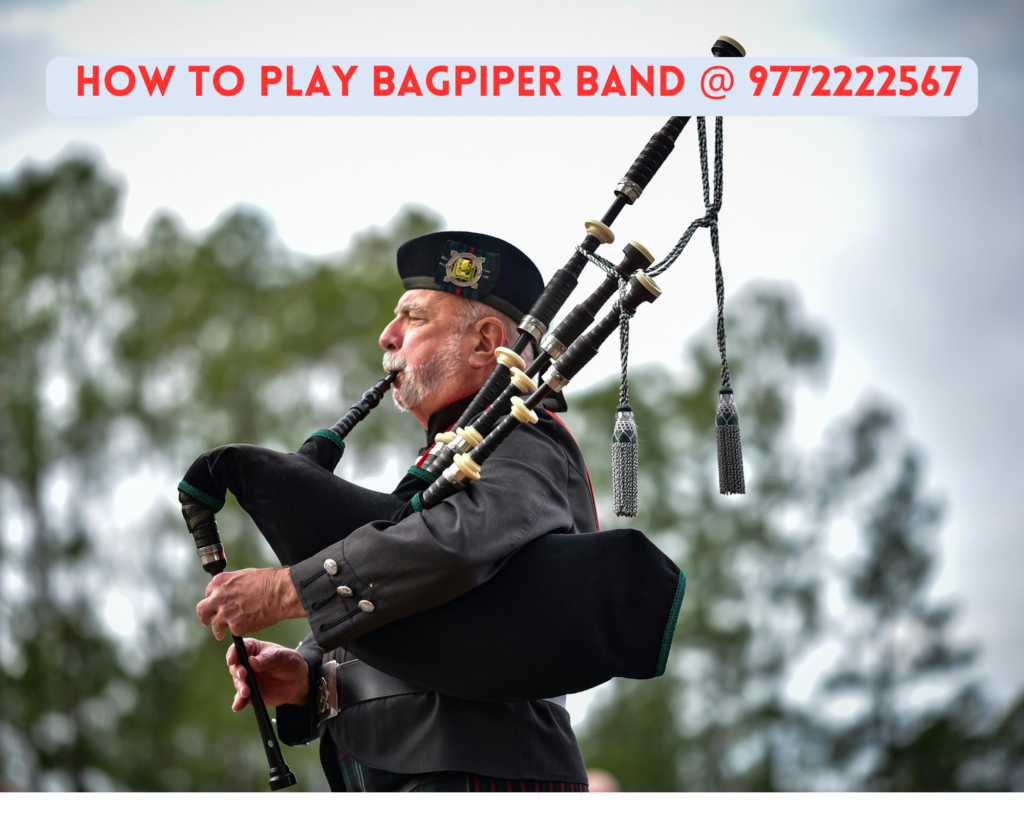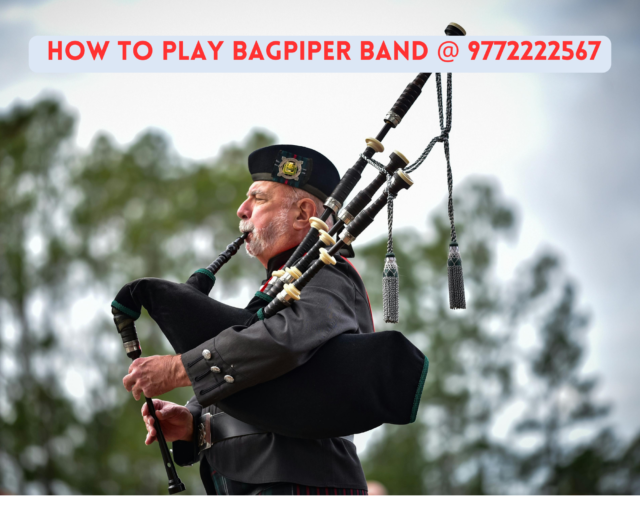How to Play Bagpipes: A Beginner’s Guide to Mastering the Art
Learning to play the bagpipes is a rewarding journey into one of the most iconic musical traditions. Known for their distinctive sound, bagpipes have been used for centuries in cultural and ceremonial settings. Whether you’re interested in Scottish heritage or exploring a unique instrument, this guide will help you get started.
Understanding the Bagpipes (How to Play Bagpipes)
Bagpipes consist of several parts that work together to produce their unique sound. Familiarizing yourself with these components is crucial for beginners: (How to Play Bagpipes)
The Bag:
The air reservoir that provides a continuous flow of air.
The Chanter:
The melody pipe where the notes are played.
The Drones:
Pipes that produce a constant harmonic background sound.
The Blowpipe:
Used to fill the bag with air.
Step 1: Get the Right Equipment @ How to Play Bagpipes
To begin, invest in a practice chanter. It is a simplified version of the chanter and is ideal for learning finger positions and basic tunes. A full set of bagpipes can be acquired later once you’re comfortable with the basics.
Step 2: Learn Proper Posture and Grip
Hold the chanter with both hands, keeping your fingers curved and relaxed. Ensure your fingers fully cover the holes to avoid air leaks. Sit upright or stand comfortably to maintain good posture, which helps in controlling airflow.
Step 3: Practice Breathing Techniques
Controlled breathing is essential for playing the bagpipes. Practice deep diaphragmatic breathing to ensure you can maintain a steady flow of air into the bag. Use your practice chanter to train your breathing and finger coordination simultaneously.
Step 4: Master Basic Fingering and Scales
Learn the nine notes of the bagpipe scale, which include low G, low A, B, C, D, E, F, high G, and high A. Practice transitioning smoothly between these notes to build muscle memory. Start with simple melodies to gain confidence.
Step 5: Build Bag Control
Once you’re comfortable with the chanter, start working with the bag. Fill it with air and practice squeezing it evenly while playing. Consistent pressure ensures a steady tone and prevents abrupt changes in pitch.
Step 6: Focus on Drone Coordination
After mastering the chanter and bag, introduce the drones. Start with one drone and gradually add others as you gain confidence. Tuning the drones to the chanter ensures harmony, so spend time adjusting them properly.
Step 7: Learn Basic Tunes and Ornamentation
Begin with simple tunes like “Amazing Grace” or traditional Scottish marches. As you improve, incorporate embellishments such as grace notes, doublings, and taorluath to enhance your playing style.
Step 8: Join a Bagpipe Band or Find a Teacher : How to Play Bagpipes (How to Play Bagpipes)
Learning from experienced players or joining a bagpipe band can accelerate your progress. They can provide valuable feedback and teach you advanced techniques.
Common Challenges for Beginners @ How to Play Bagpipes: How to Play Bagpipes
Air Leaks:
Ensure the bag and pipes are securely attached.
Finger Coordination:
Regular practice will improve accuracy and speed.
Tuning:
Use an electronic tuner to help achieve the correct pitch.
Tips for Success to How to Play Bagpipes
Practice regularly to build stamina and refine your skills.
Record yourself to identify areas for improvement.
Participate in local events to gain performance experience.
How to Play Bagpipes: Step-by-Step Guide to Master the Pipes
Ah, the bagpipes. That haunting, stirring sound that echoes across moors, marches down city streets, and sends chills down your spine at weddings and funerals alike. If you’ve ever stood in awe of a piper marching with pride, you’ve probably thought: Could I ever do that? Well, friend, the answer is yes—absolutely yes. But let’s be real: playing the bagpipes isn’t like picking up a guitar or blowing into a recorder. It’s a commitment. It’s a lifestyle. It’s equal parts art, science, and sheer stubbornness.
But don’t let that scare you off. I’ve been playing the pipes for over three decades, marched in pipe bands across continents, and taught hundreds of beginners—some who thought they’d never get past the squeak. So if you’re ready to dive in, strap on your kilt (figuratively or literally), and let’s walk through how to play bagpipes step by step.
Why the Bagpipes Are More Than Just a Musical Instrument
Let’s get one thing straight: the bagpipes aren’t just an instrument. They’re a statement. A tradition. A living, breathing piece of cultural history. When you pick up the pipes, you’re not just learning notes—you’re stepping into centuries of Highland heritage, military marches, and emotional storytelling.
And honestly? That’s part of the magic. (How to Play Bagpipes )There’s a reason bagpipe music gives people goosebumps. It’s raw. It’s powerful. It doesn’t whisper—it declares. So if you’re in it for the right reasons—not just to impress at parties, but to connect with something deeper—then you’re already on the right path.
Understanding the Bagpipes: Anatomy of the Pipes
Before you blow a single note, you need to know what you’re dealing with. The bagpipes might look like a tangled mess of tubes and leather at first glance, but every piece has a purpose. Let’s break it down.
The Bag – The Heart of the Instrument
Think of the bag as your lungs’ backup system. It stores air so you can play continuously without stopping to breathe. Made from sheepskin, goatskin, or synthetic materials, the bag inflates as you blow into it and slowly releases air to keep the sound going. It’s like a musical battery—charge it up, and it powers your performance.
But here’s the catch: if your bag leaks, you’re done. Air leaks are the silent killers of piper dreams. So treat your bag like a newborn—keep it dry, store it properly, and inspect it regularly.
The Chanter – Where the Melody Lives
This is your melody maker. The chanter is the pipe with finger holes that you use to play tunes. It’s where your fingers do the dancing. Unlike a flute or recorder, the chanter uses a double reed, which vibrates when air passes through it—producing that unmistakable, buzzy bagpipe tone.
The great thing? It only plays one octave—nine notes, to be exact (A to A). No sharps, no flats, just pure, unapologetic Scottish scale. It’s simple in theory, but mastering the finger transitions? That’s where the real work begins.
The Drones – The Soul of the Sound
Ah, the drones. Those long pipes sticking up like proud sentinels. Most bagpipes have three: two tenors and one bass. They don’t have finger holes. They don’t play melodies. But boy, do they matter.
Drones produce a constant, harmonic background note—usually A, around 476 Hz. This creates that rich, layered sound that defines the bagpipes. When they’re in tune, it’s heavenly. When they’re not? It sounds like a cat fight in a thunderstorm.
Tuning the drones to the chanter is one of the first big milestones (How to Play Bagpipes ) every piper must conquer.
Types of Bagpipes You Should Know About
Not all bagpipes are created equal. Sure, the Great Highland Bagpipes get all the glory, but there’s a whole world of pipes out there. Let’s explore the main types you might encounter.
Great Highland Bagpipes
This is the classic. The one you see in parades, war films, and Braveheart marathons. Loud, proud, and built for outdoor performance. These are mouth-blown, meaning you inflate the bag with your breath. They’re powerful—so loud, in fact, that they’ve been classified as weapons in wartime (no joke).
Perfect for marching, commanding attention, and making neighbors question your life choices.
Irish Uilleann Pipes
Now, these are the quiet intellectuals of the bagpipe family. Played sitting down, inflated with a bellows under the arm, the Uilleann pipes are softer, more nuanced, and capable of dynamics—yes, dynamics. You can play quietly or loudly, which is a big deal in the bagpipe world.
They’re used in traditional Irish music and have a sweeter, more complex tone. But they’re also more complicated to learn, so beginners usually start with Highland pipes.
Smallpipes and Other Regional Variants
From Northumbrian smallpipes to Galician gaitas, bagpipes come in all shapes and sounds. Some are quiet enough for indoor sessions, others are tuned to different scales. But for the sake of this guide, we’ll focus on the Great Highland Bagpipes—the most common starting point for new pipers.
Getting Started: Your First Steps with the Bagpipes: How to Play Bagpipes
You’re excited. You’re ready. But please—don’t rush to buy a full set of bagpipes just yet. That’s like trying to drive a Formula 1 car before you’ve learned to parallel park.
Your first tool? The practice chanter.
Choosing the Right Practice Chanter
A practice chanter is a simple, inexpensive pipe that mimics the fingerings of the real chanter. It’s quiet, portable, and perfect for learning. Most are made of plastic or wood and cost between $30 and $80.
Look for one with a stable reed and a comfortable mouthpiece. Brands like McCallum, Kron, and Naill are solid choices. Avoid the cheapest ones—they’ll frustrate you with inconsistent sound.
Blowing and Fingering: The Basics of Sound
Hold the chanter like a recorder. Left hand on top, right hand below. Cover all holes with your fingertips—no peeking! Now, gently blow into the mouthpiece. Not too hard—think “blow a dandelion,” not “blow out birthday candles.”
When you get a steady, clear note, celebrate. You’ve just made your first bagpipe sound!
The Importance of Steady Air Pressure
Here’s the golden rule: constant pressure equals consistent sound. The reed needs steady airflow to vibrate properly. Too much air? Squeal city. Too little? It cuts out like a bad Wi-Fi signal.
Practice blowing at a consistent pressure. Imagine you’re keeping a balloon floating in the air—steady, controlled, unwavering.
How to Play Bagpipes : Common Mistakes Beginners Make
Let’s save you some pain. Here are the top beginner blunders:
- Overblowing: You’re not impressing anyone with volume. You’re just creating noise pollution.
- Lifting fingers too high: Keep your fingers close to the holes. High lifts slow you down and cause mistakes.
- Ignoring posture: Sit up straight. Slouching messes with your breathing and control.
- Skipping basics: Don’t jump to “Amazing Grace” on day two. Master scales first.
Trust me, I’ve seen it all. Slow and steady wins the piper’s race.
Mastering the Practice Chanter
Now that you’ve got the basics, it’s time to get serious. The practice chanter is your training ground. This is where you’ll spend months—yes, months—before touching the full pipes.
Learning the Notes and Finger Positions
The Highland bagpipe scale is simple: G, A, B, C, D, E, F, High G, High A. That’s it. No sharps, no flats. But here’s the twist: the C and F are always C# and F#—bagpipe tuning is unique.
Start with G. Then learn A, then B. Practice each note slowly, ensuring clean transitions. Use a tuner app to check pitch. Yes, even on a chanter, pitch matters.
Once you’re comfortable, move to simple scales. G to High A and back. Repeat. Repeat. Repeat.
How to Play Bagpipes : Simple Tunes to Start With
Don’t aim for “Scotland the Brave” just yet. Start with nursery rhymes or traditional gracenotes exercises:
- “When the Battle’s O’er”
- “Blue Bonnets Over the Border”
- “The Piper’s Caveat”
These are short, repetitive, and build muscle memory. Think of them as your musical push-ups.
Developing Finger Speed and Accuracy
Bagpipe music is fast. Really fast. And it’s full of gracenotes—tiny, rapid finger taps that decorate the main notes. These are what give the pipes their bouncy, rhythmic feel.
Start slow. Use a metronome. Practice gracenotes on each finger. Build strength and precision. Your fingers will ache at first—normal. It’s like building calluses on a guitar, but for your entire hand.
How to Play Bagpipes–Moving On: From Chanter to Full Bagpipes
Congratulations. You can play a few tunes on the chanter. Your neighbors tolerate you. It’s time to graduate.
But hold up—don’t just strap on a set of pipes and expect magic. The full bagpipes are a beast.
Assembling Your Bagpipes Safely
First, check everything:
- Bag: dry and airtight
- Chanter reed: moistened and responsive
- Drone reeds: in good condition
- Stocks: clean and snug
Assemble in this order:
- Insert the drones into the bag (tenors first, then bass).
- Attach the blowpipe.
- Insert the chanter last—always last. Why? Because once the chanter’s in, you’re ready to play.
Handle reeds like eggs. They’re fragile. And expensive.
How to Play Bagpipes-Balancing the Drones – Tuning Is Everything
This is where many new pipers hit a wall. Tuning the drones takes patience.
Start with the bass drone. Slide the tuning pin until it matches the low A on your chanter. Then tune the tenor drones to the same note. Use your ear, a tuner, or a tuning app.
Now, play a few notes. If the sound is smooth and full, you’re golden. If it’s wobbly or harsh, tweak the slides—tiny adjustments only.
And remember: temperature and humidity affect tuning. Pipes go out of tune constantly. That’s normal.
The Art of Bag Pressurization
Now, the real test: keeping the bag inflated while playing.
Blow into the blowpipe, seal your mouth, and squeeze the bag with your arm. The goal? Maintain constant pressure so the sound never wavers.
It’s like patting your head and rubbing your stomach—while juggling. At first, your sound will waver. You’ll squeak. You’ll huff and puff like a steam engine.
But with practice, it becomes second nature. Your arm learns the rhythm. Your breath syncs with the squeeze.
How to Play Bagpipes-Breathing Techniques Every Piper Must Master
Breathing is everything. Literally. If you run out of air, the music stops. So you need a system.
Circular Breathing vs. Mouth Inflation
Some instruments use circular breathing (inhaling through the nose while pushing air out with cheek muscles). Not the bagpipes. We use mouth inflation with breath control.
Here’s how it works:
- Blow into the pipe to fill the bag.
- Seal your lips.
- Use your arm to squeeze air out while you quickly inhale through your nose.
- Resume blowing.
It’s a cycle: blow, squeeze, breathe, repeat. Smooth, seamless, relentless.
Practice this dry—without playing—until it feels natural.
How to Play Bagpipes-Using a Blowstick: Pros and Cons
Some pipers use a blowstick—a one-way valve that lets air in but not out. It prevents saliva from entering the bag (a big plus). But it also adds resistance, making inflation harder.
Beginners might skip it at first. Once you’re comfortable, try one and see if you like it.
Common Challenges and How to Overcome Them
Let’s be real: the bagpipes are hard. But every challenge has a solution.
Staying in Tune: The Piper’s Eternal Battle
Even after tuning, your pipes will drift. Why? Because heat from your breath changes the reeds. Humidity messes with the wood. Your arm pressure fluctuates.
Solution? Tune, tune, and tune again. Before every practice. Before every performance. In the middle of long tunes, if needed.
And train your ear. Learn to hear when a drone is sharp or flat. It’s a skill that develops over time.
How to Play Bagpipes: Dealing with Air Leaks and Bag Issues
If your bag won’t hold air, check the seams, the valves, and the blowpipe seal. A tiny leak can ruin your session.
Keep a repair kit handy: beeswax for stocks, duct tape (in a pinch), and spare reeds.
And never, ever leave your pipes in a hot car. Heat warps wood, melts wax, and kills reeds.
The Mental Game: Patience and Persistence
Let’s talk about the real secret to mastering the bagpipes: not giving up.
You’ll have days when nothing works. When your fingers freeze. When your drones sound like dying geese. When your family begs you to stop.
But then—there’s a day when it all clicks. When you play a tune start to finish without a mistake. When the sound fills the room like thunder.
That’s the moment you’ll remember why you started.
So be patient. Practice daily—even 15 minutes counts. Celebrate small wins. And keep showing up.
Joining a Pipe Band or Finding a Mentor
You don’t have to do this alone. In fact, you shouldn’t.
How to Play Bagpipes: The Joy of Playing in a Group
Pipe bands are like musical families. Everyone supports each other. You’ll learn faster, stay motivated, and experience the thrill of playing in harmony.
Plus, there’s nothing like the feeling of marching in unison, 20 sets of pipes roaring in perfect tune.
How a Mentor Can Accelerate Your Progress
A good teacher can save you years of bad habits. They’ll correct your posture, refine your finger technique, and help you tune like a pro.
Look for local pipe bands, music schools, or online instructors. Even one lesson a month can make a huge difference.
How to Play Bagpipes: Practice Routines That Actually Work
Want results? Structure your practice.
Daily Drills for Finger Dexterity
Spend 10 minutes on:
- Scale runs (G to High A)
- Gracenote exercises
- Doublings and birls (advanced embellishments)
Use a metronome. Start slow, then increase speed.
Drone Tuning and Ear Training
Dedicate 5 minutes per session to tuning. Close your eyes. Listen. Adjust. Repeat.
Over time, your ear will become your best tuning tool.
Playing with Expression and Confidence
Once you’ve mastered the notes, focus on how you play. Are you rushing? Are your gracenotes crisp? Is your tone steady?
Record yourself. Listen back. Be your own critic.
And when you play, own it. The bagpipes demand confidence. Stand tall. Breathe deep. Let the music roar.
How to Play Bagpipes:
Learning to play the bagpipes isn’t a sprint—it’s a march. A long, winding, occasionally frustrating, but ultimately glorious march. It will test your patience, your lungs, and your willpower. But when you finally nail that tune, when the drones hum in perfect harmony, when you feel the music vibrate in your chest—you’ll know it was worth every second.
So start with the practice chanter. Respect the process. Find your rhythm. And remember: every master piper was once a beginner who refused to quit.
Now go make some noise.
How to Play Bagpipes: Frequently Asked Questions (FAQs)
Can I learn bagpipes on my own?
Absolutely. With the right resources and discipline, self-teaching is possible. But a mentor can dramatically speed up your progress and prevent bad habits.
How long does it take to learn the bagpipes?
Basic proficiency takes 6–12 months with consistent practice. Mastery? That’s a lifelong journey.
Are bagpipes hard to carry?
They’re not light—typically 6–8 pounds—but designed to be carried comfortably with a harness. Once you’re used to the weight, it’s manageable.
Can I play indoors?
Yes, but be mindful of volume. Use practice chanters indoors, and consider a practice pad or electronic bagpipe for quiet sessions.
Do I need to be Scottish to play the bagpipes?
Not at all! The bagpipes belong to anyone passionate enough to learn. Some of the best pipers I know are from Japan, Australia, and Texas.( How to Play Bagpipes)
Learning to play the bagpipes requires dedication, patience, and consistent practice. By mastering the fundamentals and gradually advancing your skills, you can join the ranks of skilled bagpipers who bring this timeless instrument to life. Embrace the journey, and soon, you’ll be captivating audiences with the powerful and melodic sound of the bagpipes. (How to Play Bagpipes )

Tags: How to Play Bagpipes, How to Play Bagpipes for Beginners, Learn to Play the Bagpipes, Bagpipe Playing Lessons, Bagpipe Instruction, Beginner Bagpipe Lessons, How to Learn to Play Bagpipes, Bagpipe Playing Tips, Easy Bagpipe Tunes for Beginners, Bagpipe Lessons for Adults,
Bagpipe Lessons for Kids, Best Bagpipe Teachers, Where to Learn to Play Bagpipes, Bagpipe Playing Techniques, Bagpipe History and Playing, How to Maintain Bagpipes, Bagpipe Playing Resources, Bagpipe Playing Tips and Tricks, Learn to Play the Bagpipes Online, Bagpipe Playing for Beginners, The Basics of Bagpipe Playing, How to Get Started Playing the Bagpipes.




